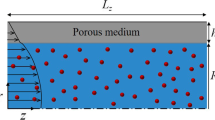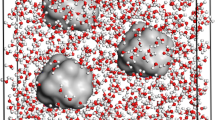Abstract
We present data and predictive models for the shear rheology of suspended zeolite particles in polymer solutions. It was found experimentally that suspensions of zeolite particles in polymer solutions have relative viscosities that dramatically exceed the Krieger–Dougherty predictions for hard sphere suspensions. Our investigations show that the major origin of this discrepancy is due to the selective absorption of solvent molecules from the suspending polymer solution into zeolite pores. The effect raises both the polymer concentration in the suspending medium and the particle volume fraction in the suspension. Consequently, both the viscosity of the polymer solution and the particle contribution to the suspension viscosity are increased. We propose a predictive model for the viscosity of porous zeolite suspensions by incorporating a solvent absorption parameter, α, into the Krieger–Dougherty model. We experimentally determined the solvent absorption parameter by comparing viscosity data for suspensions of porous and nonporous MFI zeolite particles. Our results are in good agreement with the theoretical pore volume of MFI particles.









Similar content being viewed by others
References
Batchelor GK (1977) Effect of Brownian-motion on bulk stress in a suspension of spherical-particles. J Fluid Mech 83:97–117
Booth F (1950) The electroviscous effect for suspensions of solid spherical particles. Proc R Soc Lond Ser A-Math Phys Sci 203:533–551
Cheng CH, Bae TH, McCool BA, Chance RR, Nair S, Jones CW (2008) Functionalization of the internal surface of pure-silica MFI zeolite with aliphatic alcohols. J Phys Chem C 112:3543–3551
Chung TS, Jiang LY, Li Y, Kulprathipanja S (2007) Mixed matrix membranes (MMMs) comprising organic polymers with dispersed inorganic fillers for gas separation. Prog Polym Sci 32:483–507
de Oliveira IS, van den Noort A, Padding JT, den Otter WK, Briels WJ (2011) Alignment of particles in sheared viscoelastic fluids. J Chem Phys 135:104902
Einstein A (1906) A new determination of the molecular dimensions. Ann Phys 19:289–306
Einstein A (1911) A new determination of the molecular dimensions (vol 19, pg 289, 1906). Ann Phys 34:591–592
Ekiner OM, Vassilatos G (1990) Polyaramide hollow fibers for hydrogen methane separation–spinning and properties. J Membr Sci 53:259–273
Ekiner OM, Vassilatos G (2001) Polyaramide hollow fibers for H 2/CH 4 separation–II. Spinning and properties. J Membr Sci 186:71–84
Flanigen EM, Bennett JM, Grose RW, Cohen JP, Patton RL, Kirchner RM, Smith JV (1978) Silicalite, a new hydrophobic crystalline silica molecular-sieve. Nature 271:512–516
Fyfe CA, Gobbi GC, Klinowski J, Thomas JM, Ramdas S (1982) Resolving crystallographically distinct tetrahedral sites in silicalite and ZSM-5 by solid-state NMR. Nature 296:530–533
Husain S (2006) Mixed matrix dual layer hollow fiber membranes for natural gas separation. PhD Dissertation, Georgia Institute of Technology, Atlanta
Husain S, Koros WJ (2007) Mixed matrix hollow fiber membranes made with modified HSSZ-13 zeolite in polyetherimide polymer matrix for gas separation. J Membr Sci 288:195–207
Jeffery GB (1922a) The motion of ellipsoidal particles in a viscous fluid. Proc Roy Soc (London), Ser A-Containing Papers Mathematical Physical Character 102:161–179
Jeffery GB (1922b) The rotation of two circular cylinders in a viscous fluid. Proc R Soc Lond Ser A-Containing Papers Mathematical Physical Character 101:169–174
Kitano T, Kataoka T, Shirota T (1981) An empirical equation of the relative viscosity of polymer melts filled with various inorganic fillers. Rheol Acta 20:207–209
Krieger IM, Dougherty TJ (1959) A mechanism for non-Newtonian flow in suspensions of rigid spheres. Trans Soc Rheol 3:137–152
Mahajan R, Koros WJ (2000) Factors controlling successful formation of mixed-matrix gas separation materials. Ind Eng Chem Res 39:2692–2696
Mahajan R, Koros WJ (2002a) Mixed matrix membrane materials with glassy polymers. Part 1. Polym Eng Sci 42:1420–1431
Mahajan R, Koros WJ (2002b) Mixed matrix membrane materials with glassy polymers. Part 2. Polym Eng Sci 42:1432–1441
Malkin AY (2012) Non-Newtonian viscosity in steady-state shear flows. J Non-Newtonian Fluid Mech 192:48–65
Metzner AB (1985) Rheology of suspensions in polymeric liquids. J Rheol 29:739–775
Moore TT, Mahajan R, Vu DQ, Koros WJ (2004) Hybrid membrane materials comprising organic polymers with rigid dispersed phases. AIChE J 50:311–321
Mueller S, Llewellin EW, Mader HM (2010) The rheology of suspensions of solid particles. Proc R Soc A-Math Phys Eng Sci 466:1201–1228
Pabst W, Gregorova E, Berthold C (2006) Particle shape and suspension rheology of short-fiber systems. J Eur Ceram Soc 26:149–160
Pasquino R, Grizzuti N, Maffettone PL, Greco F (2008) Rheology of dilute and semidilute noncolloidal hard sphere suspensions. J Rheol 52:1369
Pasquino R, Panariello D, Grizzuti N (2012) Migration and alignment of spherical particles in sheared viscoelastic suspensions. A quantitative determination of the flow-induced self-assembly kinetics. J Colloid Interface Sci 394:49–54
Paul DR, Kemp DR (1973) Diffusion time lag in polymer membranes containing adsorptive fillers. J Polym Sci Part C-Polym Symp 41:79–93
Robeson LM (1991) Correlation of separation factor versus permeability for polymeric membranes. J Membr Sci 62:165–185
Robeson LM (2008) The upper bound revisited. J Membr Sci 320:390–400
Russel WB (1976) Low-shear limit of secondary electroviscous effect. J Colloid Interface Sci 55:590–604
Schoeman BJ (1997a) A spectroscopic study of the initial stage in the crystallization of TPA-silicalite-1 from clear solutions. In: Chon H, Ihm SK, Uh YS (eds) Progress in zeolite and microporous materials, Pts a-C, vol 105, pp 647–654
Schoeman BJ (1997b) The homogeneous nature of clear TPA-silicalite-1 precursor solutions. Microporous Mater 9:267–271
Snijkers F, Pasquino R, Vermant J (2013) Hydrodynamic interactions between two equal-sized spheres in viscoelastic fluids in shear flow. Langmuir 29:5701–5713
Stimson M, Jeffery GB (1926) The motion of two spheres in a viscous fluid. Proc R Soc Lond Ser A-Containing Papers Mathematical Physical Character 111:110–116
Vaynberg KA, Wagner NJ (2001) Rheology of polyampholyte (gelatin)-stabilized colloidal dispersions: the tertiary electroviscous effect. J Rheol 45:451–466
Wallace DW, Staudt-Bickel C, Koros WJ (2006) Efficient development of effective hollow fiber membranes for gas separations from novel polymers. J Membr Sci 278:92–104
Watterson IG, White LR (1981) Primary electroviscous effect in suspensions of charged spherical-particles. J Chem Soc-Faraday Trans Ii 77:1115–1128
Zhou Z, Solomon MJ, Scales PJ, Boger DV (1999) The yield stress of concentrated flocculated suspensions of size distributed particles. J Rheol 43:651
Zurita L, Carrique F, Delgado AV (1994) The primary electroviscous effect in silica suspensions - ionic-strength and ph effects. Colloids Surf A-Physicochem Eng Aspects 92:23–28
Acknowledgments
We are grateful to the ExxonMobil Corporation for the financial support for this work. We also wish to express our gratitude to Professors Bill Koros and Chris Jones for numerous discussions on this work.
Author information
Authors and Affiliations
Corresponding author
Rights and permissions
About this article
Cite this article
Olanrewaju, K.O., Bae, TH., Nair, S. et al. The rheology of suspensions of porous zeolite particles in polymer solutions. Rheol Acta 53, 133–141 (2014). https://doi.org/10.1007/s00397-013-0746-y
Received:
Revised:
Accepted:
Published:
Issue Date:
DOI: https://doi.org/10.1007/s00397-013-0746-y




